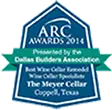NATURAL CORK PLANK – When applied to cork, the term ‘plank’ refers to a floating floor installation, where cork has been laminated to a fiberboard center core with a tongue & groove edge. This allows for several advantages:
1. Subfloor preparation is less stringent
2. The floor ‘floats’ and is less visibly affected by expansion and contraction normal to wood products
3. Plank can be installed below grade
4. Installation is relatively quick
5. Thicker product provides better insulation
As is common with other floating products, Natural Cork plank requires a perimeter expansion space that must be covered by baseboard or other trim. The necessity for perimeter expansion makes it difficult to use plank in a place where it will not be convenient to install trim pieces. This is particularly true in most bathrooms where roll-edged tubs and floor-mounted toilets are common. Therefore, it is recommended to use Natural Cork tile in bathroom applications.
Natural Cork plank products are milled with a specially shaped “click” together tongue & groove center core. This sophisticated and highly accurate milled shape ensures a very tight connection during installation and beyond. Click technology is a glueless installation resulting in less mess, less fuss, and less time on the job. What’s more, floors that are clicked into place and also be unclicked for easy repair.
WHAT TO LOOK FOR:
DENSITY – Product density is determined by the size of the cork granules used. Larger granules have fewer voids to be filled by binding agents and therefore produce a higher density cork. Large cork granules, with high density, are used as the top layer of all Natural Cork floating floors and parquet tiles to ensure the durability of the floor. Lower density cork is only used on the bottom layer of the floating floor plank for added thermal, acoustical, and mold resistance properties.
FINISH – Natural Cork can be purchased unfinished but, unlike some wood, it must be finished upon installation. Though some people continue to prefer paste wax, the most common finish today is polyurethane. There are suppliers who offer cork with a vinyl coating that is low maintenance but cannot be refinished or easily repaired. The latest development in finishes is “anti-scratch”, a more durable coating.
THICKNESS – The thickness of the Natural Cork wear layer has less to do with durability than will density. However, it will be a source of improved insulation both acoustic and thermal. A good standard thickness is 4 mm for parquet tiles, while a 3 mm top layer and 2-3 mm bottom layer are good for floating floors with an HDF core.
MAINTENANCE
With Natural Cork, lasting beauty can be achieved through purchasing a top-quality material and providing proper ongoing maintenance.
Providing proper maintenance begins with remembering two key properties of cork, its ability to fade with exposure to light and the fact that it will react to heat and humidity.
Natural Cork contains organic pigments. Just like other wood products, Natural Cork will fade over time and should never be exposed directly to sunlight. Using drapes or other systems to protect your floor from excessive light will slow down this process. Cork will naturally be yellow or mellow with age. Uneven exposure to light sources will cause uneven aging so it is a good idea to rotate furnishings periodically.
All wood floor systems expand and contract in response to fluctuations in temperature and humidity. By controlling the environment, maintaining a moderate temperature and relative humidity of around 50%, one can minimize the visible effects of the normal contraction and expansion of your floor. It is important to sweep or vacuum the floor regularly in order to avoid the build-up of abrasive particles that can scratch the finish. Most cleaners specified for use on pre-finished hardwood will also work with Natural Cork, but be sure to read the packaging for correct information. These cleaners should be sprayed or misted over the surface and damp-mopped up as you go. It is not a good idea to use the old “bucket and mop” cleaning method on a Natural Cork floor. Spills should be wiped up immediately.
In the kitchen, use a non-rubber-backed rug in front of working areas such as in front of the stove and sink to prevent local premature wear. Weight distribution is a key factor in preventing indentation. To minimize impressions in the resilient cork, furniture should have proper protectors under feet, and furniture with casters should have wide casters. Protective mats are a good idea under office chairs.
REFINISHING OPTIONS
Most Natural Cork decorative patterns are made of thin veneer laminated to a cork base. Failure to maintain the finish could result in irreparable damage to this pattern layer. The longevity of the finish can be directly related to traffic intensity and quality of floor care. When a Natural Cork floor starts to show a traffic pattern and signs of wear, it is time to renew the finish.
URETHANE – For Natural Cork floors finished with an acrylic finish, a new coat of polyurethane will make the floor look new again and prolong its lifespan. The entire floor will need to be gently abraded and thoroughly cleaned before applying one or two coats of high-quality water-based polyurethane. The finish will then need to cure for a minimum of 48 hours prior to replacing furniture or receiving heavy traffic. The greatest success will be achieved through hiring qualified flooring professionally for this process. Under normal use in a residential environment, a urethane finish should last between 8 – 10 years between refinishing.
It is possible to stain or paint your Natural Cork floor at the same time you reapply a polyurethane finish provided you are able to buff through all layers of finish and get down to the raw cork without sanding through any applied veneer. Raw or unfinished cork will accept stain and paint formulated for use on other wood products. A roller application will offer the best chance of complete and even coverage. Lap marks are likely to show up so careful attention to detail is important.
COMMERCIAL – For commercial applications, anti-scratch water-based finishes perform well and are easier to maintain and resurface than traditional acrylic coatings.
WAX – When necessary, wax finished floors will need to be stripped and have a new coat of paste wax buffed into the surface. Not all paste wax is appropriate, so be certain that use on Natural Cork is specified on the product label. In most cases, this will be necessary every 18 months to two years. Polyurethane cannot be applied to a previously waxed Natural Cork floor as wax penetrates deeply into the material and will not allow urethane to adhere properly ultimately causing the finish to delaminate.
Natural Cork that has been finished with curable oil or hard wax oil will be cared for through spot application of maintenance products to traffic areas only. Provided the finish is properly maintained, it will not be necessary to strip and refinish an oiled cork floor.
Natural Cork is enjoying a resurgence in popularity today. From television design shows to shelter magazines, Natural Cork is seemingly everywhere and ostensibly the “hottest new product” on the market.
Many people think of cork as a relatively new and possibly unreliable option, particularly as a surface flooring material. And yet, there are examples of Natural Cork floors in public buildings that were installed over 100-years ago and are still in use today. The Library of Congress in Washington, DC is one excellent case.
THE NATURAL CORK TREE
A member of the beech family, Quercus Suber, or the cork oak tree grows in coastal regions of the Mediterranean. Seven countries comprise the bulk of the area where cork oak will grow. These countries are Portugal, Spain, France, Italy, Algeria, Morocco, and Tunisia with the majority of the production occurring in Portugal and Spain. Relatively slow-growing, cork trees survive harsh conditions in depleted soil that will often support little else of value. There are examples of cork oak trees that are 400 to 500 years old, though the average life expectancy would be 120 to 200 years.
Unlike most trees where primary value is derived from the lumber of the trunk, Natural Cork is actually obtained from the bark of the tree. This unusually thick bark is made up of millions of tiny prism-shaped air pockets which create a resilient cushiony surface that offers several distinct advantages to the tree. Natural Cork is a natural fire inhibitor so the bark provides protection from wildfires common to the region. An inherent waxy substance, suberin, serves as an insect repellant eliminating threats from many usual agricultural pests. And the bark is regenerative, so its protective properties will grow back if damaged in any way.


















